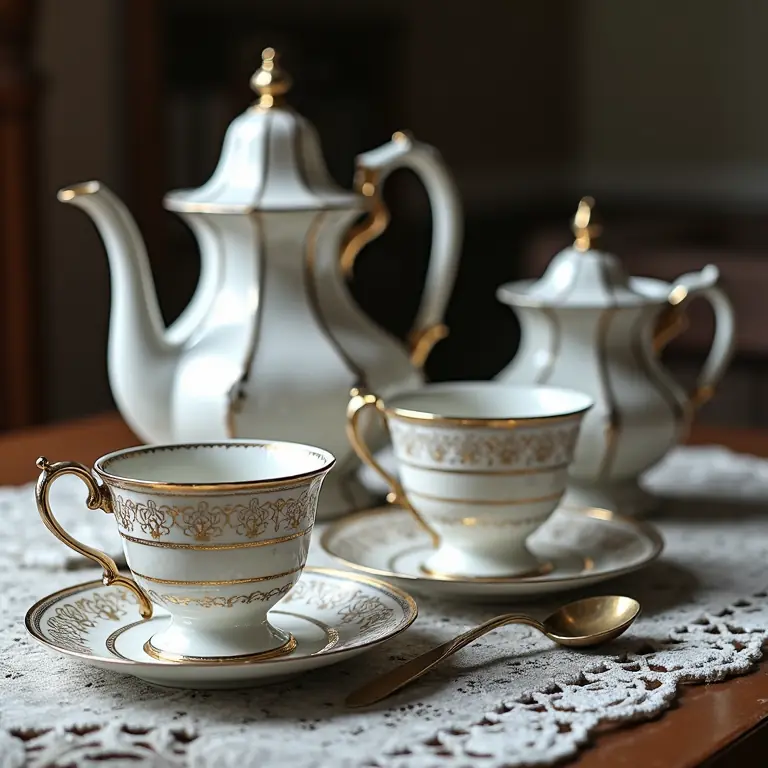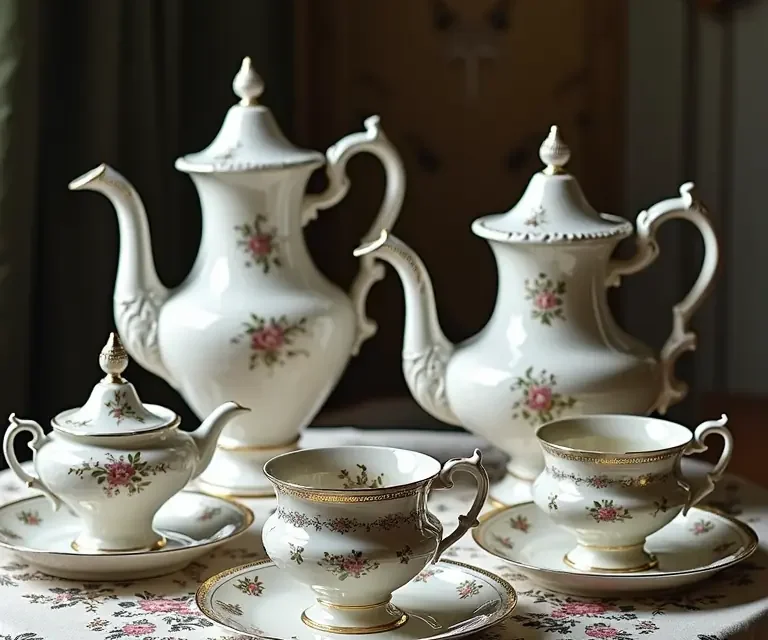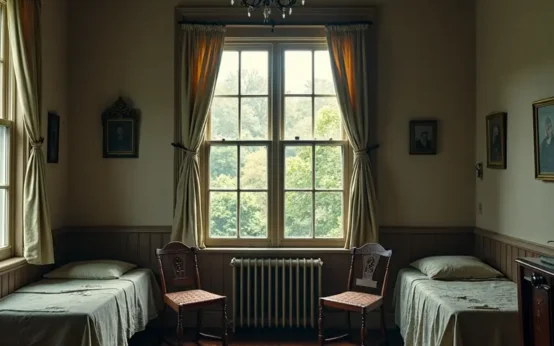The delicate clink of porcelain, the gentle curve of a teapot spout, the precisely angled handle of a teacup – these elements of antique tea services are often appreciated for their aesthetic beauty and association with a refined social ritual. But beneath the surface of elegance lies a fascinating world of geometry, meticulously considered form, and subtle engineering. This article explores the surprising mathematical and geometric principles that shaped the design of these objects, how those principles relate to their function, and how the very act of using a tea service was steeped in a carefully choreographed social geometry.
A History of Shapes: From East to West
The story of the tea service is inextricably linked to the history of tea itself. Originating in China, the practice of tea drinking gradually spread westward, evolving along the way. Early Chinese tea wares, dating back centuries, demonstrate a sophisticated understanding of ceramic form. The yixing teapots, for example, are celebrated for their organic shapes, often inspired by natural forms like gourds or pebbles. While appearing ‘natural’, these shapes are not accidental. They’re carefully calculated to influence the flow of tea, the retention of heat, and even the perceived taste. The use of specific clay types, and the precise manipulation of the teapot’s form, reflects a deep understanding of material science and fluid dynamics – disciplines that, while not formally codified as such at the time, were intuitively grasped by skilled potters.
When tea reached Europe in the 17th century, it was initially a luxury enjoyed by the elite. Early European tea services were often adaptations of existing tableware – repurposed porcelain from the East, or imitations crafted in silver. However, as tea’s popularity grew, so too did the demand for dedicated tea wares. The 18th and 19th centuries witnessed a flourishing of porcelain production, particularly in England, and with it, a distinct European style of tea service emerged. This style, while drawing inspiration from Eastern forms, quickly developed its own aesthetic vocabulary, characterized by a greater emphasis on symmetry, ornamentation, and a refinement of geometric principles.
The Geometry of the Teapot: Pouring Perfection
The teapot, arguably the most iconic element of a tea service, is a masterclass in applied geometry. Its seemingly simple form is a result of carefully balancing several competing factors: capacity, stability, heat retention, and, crucially, the pour. The shape of the teapot’s body dictates its internal volume, and the curvature of its sides affects how efficiently heat is distributed and retained. However, it’s the spout that truly showcases the geometric ingenuity at play.
The spout’s design isn’t simply about directing the flow of liquid. Its angle, length, and the shape of its aperture are all critical to preventing drips and ensuring a smooth, controlled pour. The principle of the Venturi effect, though not understood in its formal scientific terms by early teapot designers, is at work here. The narrowing of the spout creates a pressure difference that helps to break the surface tension of the tea, allowing it to flow cleanly. The slight upward curve often seen in teapot spouts also contributes to this effect, preventing the tea from adhering to the underside of the spout and causing drips. A well-designed spout isn’t merely functional; it’s a testament to a subtle understanding of fluid dynamics and geometric precision. Consider the implications of even a slight deviation in the spout’s angle – a poorly designed spout can result in a messy, uncontrolled pour, disrupting the elegance of the tea service.
The handle, too, is a geometric consideration. Its shape and placement must provide a comfortable and secure grip, while also balancing the weight of the full teapot. The arc of the handle is often designed to distribute the weight evenly, minimizing strain on the wrist. The angle at which the handle attaches to the body is also crucial for stability. A handle that’s too close to the center of gravity can make the teapot feel unstable, while a handle that’s too far away can make it difficult to control.
The Teacup and Saucer: Circles, Curves, and Comfort
The teacup and saucer, seemingly simpler in design than the teapot, also embody geometric considerations. The classic teacup shape – a slightly flared cylinder – is designed to maximize heat retention and allow the tea to cool slightly before drinking. The curvature of the cup’s sides also influences the aroma of the tea, directing the fragrant vapors towards the drinker’s nose. The saucer, traditionally circular, serves both a practical and a social function. It catches drips, preventing spills, and provides a resting place for the spoon. But its circular shape also has a subtle psychological effect, creating a sense of completeness and balance.
The size of the cup is also geometrically significant. Different types of tea were traditionally served in different-sized cups, reflecting the brewing method and the desired drinking experience. For example, delicate porcelain cups were often used for green tea, while larger, more robust cups were favored for black tea. This demonstrates an awareness of how the vessel itself can influence the perception of taste and aroma.
The Sugar Bowl and Cream Jug: Symmetry and Proportion
The sugar bowl and cream jug, often included in a complete tea service, frequently exhibit a strong emphasis on symmetry and proportion. Their shapes often mirror each other, creating a sense of visual harmony. The use of elliptical or oval forms, common in many antique sugar bowls and cream jugs, is a deliberate choice. These shapes are aesthetically pleasing and also provide a larger surface area for cooling, preventing the sugar or cream from warming up too quickly. The handles on these pieces are also carefully designed to provide a comfortable and secure grip, similar to the teapot handle. The overall aesthetic of these components contributes to the feeling of abundance and hospitality associated with a formal tea service.

The Social Geometry of the Tea Service
Beyond the geometric considerations of the objects themselves, the act of using a tea service was also steeped in a carefully orchestrated social geometry. The arrangement of the tea table, the placement of the cups and saucers, and the precise movements involved in pouring and serving tea were all governed by unwritten rules of etiquette. This etiquette wasn’t arbitrary; it was a complex system designed to maintain social order and reinforce hierarchies.
The position of the host and guests around the tea table, the direction in which the tea was poured, and even the way the cup was held all conveyed subtle messages about social status and relationships. The tea service, therefore, wasn’t just a collection of objects; it was a tool for social navigation. The ritual of tea drinking provided a framework for interaction, allowing individuals to express their politeness, their deference, and their social aspirations.
The careful consideration of spatial arrangement and social cues echoes patterns we see in other formalized rituals and even in the arrangement of physical spaces designed to influence behavior. For a deeper dive into the hidden patterns in everyday life, see the hidden physics of everyday rhythms.
Materials and Manufacturing: Geometric Constraints and Opportunities
The materials used in antique tea services – porcelain, silver, glass – also imposed geometric constraints and opportunities on the design process. Porcelain, for example, is relatively strong in compression but weak in tension. This means that porcelain objects must be designed to distribute stress evenly, avoiding sharp corners or thin walls that could be prone to cracking. The process of firing porcelain also introduces geometric challenges. The material shrinks during firing, and this shrinkage must be carefully accounted for in the initial design. Silver, on the other hand, is more malleable and can be shaped into more complex forms. However, it is also heavier than porcelain, which affects the balance and stability of the tea service.
The techniques used to manufacture these objects – hand-painting, molding, casting – also influenced their geometric characteristics. Hand-painting allowed for intricate decorative patterns, while molding and casting enabled the mass production of standardized forms.
The Influence of Architectural Styles
The design of antique tea services often reflected the prevailing architectural styles of the time. For example, tea services produced during the Georgian era frequently incorporated neoclassical motifs, such as fluted columns, symmetrical ornamentation, and geometric patterns. The Victorian era, with its emphasis on ornamentation and eclecticism, saw tea services adorned with intricate floral designs, elaborate gilding, and a variety of geometric patterns. The Art Nouveau movement, with its flowing lines and organic forms, inspired tea services that were characterized by their asymmetrical shapes and naturalistic motifs. These influences demonstrate how the design of tea services was not isolated from broader cultural trends.
Geometric Patterns and Symbolism
The geometric patterns used to decorate antique tea services were often imbued with symbolic meaning. For example, floral patterns symbolized beauty, fertility, and renewal, while geometric motifs like stripes and chevrons represented order, stability, and progress. The use of specific colors also carried symbolic weight. Blue was often associated with royalty and spirituality, while green symbolized hope and growth. These symbolic associations added another layer of meaning to the tea service, transforming it from a mere functional object into a cultural artifact. For a deeper understanding of the symbolic language of everyday objects, explore the symbolism of antique fans.
The Legacy of Geometric Design
The geometric principles that shaped the design of antique tea services continue to influence contemporary tableware design. Modern designers often draw inspiration from the elegance and functionality of antique forms, incorporating geometric patterns, symmetrical arrangements, and ergonomic considerations into their creations. The emphasis on balance, proportion, and visual harmony, so characteristic of antique tea services, remains a cornerstone of good design. The enduring appeal of these objects lies not only in their aesthetic beauty but also in their underlying geometric intelligence.
Beyond the Teacup: Geometry in Other Domestic Rituals
The attention to geometric detail in tea services isn’t unique. Throughout history, objects used in domestic rituals – from clocks to musical instruments – have been shaped by mathematical principles. The precise construction of a clock tower, for example, relies on complex geometric calculations to ensure accurate timekeeping and structural stability. The calculus of clock towers demonstrates this beautifully. Similarly, the design of musical instruments, such as violins and pianos, involves a deep understanding of acoustics and geometric form to produce optimal sound quality. The resonance of forgotten instruments showcases the interplay between geometry and artistry in sound production. Even seemingly simple objects, like knotted cords used for record-keeping in ancient civilizations, reveal a surprising level of mathematical sophistication. The science of knot-based record-keeping demonstrates this.
In conclusion, the unexpected geometry of antique tea services reveals a fascinating intersection of art, science, and social ritual. These objects are not merely beautiful decorations; they are tangible expressions of human ingenuity, a testament to our enduring fascination with form, function, and the subtle power of geometric precision.


 The Surprisingly Consistent Logic of Ancient Boarding House Rules – Social Order & Domestic Governance
The Surprisingly Consistent Logic of Ancient Boarding House Rules – Social Order & Domestic Governance